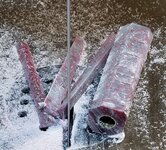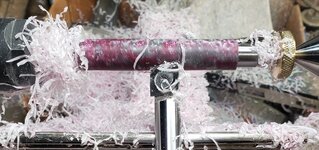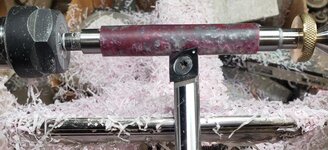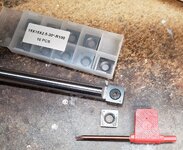There is a limit to how "fast" you can remove material with some resins. If you push the tool in too hard, I've found that pretty much any of the resins I turn will start to chip out. For alumilite as well as some other resins, you just need to take it slower...more passes removing thinner layers of material. With acrylic, I can remove almost as much as I want at a time, although I still find that if I'm too aggressive, I get ripples and other surface defects that can then be harder to get out later (usually requires more aggressive sanding, which has its own problems).
With a NR Carbide, I mostly use the same technique. I guess I don't really go "strait in". I have the tool at an angle, maybe 45 degrees on the rest, and I push in near the middle of the blank and move towards the end. Repeat a few passes of that, starting farther and farther to the other end, removing more of the bulk of the material. Once I have just a bit of material at one end, I reorient myself and the tool so I can go the other way, and just work down that bit.
I will say, when I first start, when the blank is totally square (I never cut off corners or anything like that, haven't felt the need), I start pretty light. I take off just a tiny bit of the corners at first in long passes along the entire length of the blank, until the corners are gone. Only after doing that, do I start trying to take off bulk material. I also make sure I stop with my more aggressive passes once the blank is round. Aggressive passes leave an uneven surface (at least for me), so I only just round the blank. Once its fully round, I then use more careful, slower passes to clean up the surface and work it down into my desired shape. Depending on the resin, you may get either streams of resin flowing off the blank, or the stream may immediately bundle and bunch up into a little...resin schrunchie for lack of a better term; other materials may just end up powder, or little flakes (trustone/faux stone, etc. tend to just powderize; alumilite, at least what I've turned so far, seems to be somewhere inbetween).
I like to take smaller layers of material off at this point, as I can keep the blank nice and smooth and free of those ridges and ripples and bumps you get when trying to take off say a millimeter or more of material each pass. It takes a bit longer to turn, but in the end you can get a pretty smooth, clean, reflective finish (still needs sanding and polishing, but the blank should be nice and clean and pretty darn smooth when you are done turning.)






